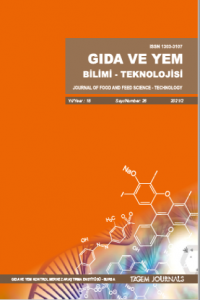Kombine güneş enerjisi destekli hava ve sıcak hava destekli radyo frekans kurutma sistemiyle kurutulan kayısıların nem içeriği, tekstürel ve duyusal özellikleri üzerine depolamanın etkisi
kayısı, güneş enerjisi destekli havalı kurutma, radyo frekans kurutma, duyusal analiz, tekstürel analiz
Effects of storage on moisture content, textural and sensory properties of apricot dried by combined solar energy assisted air-drying and hot air assisted radio-frequency drying system
apricot, solar assisted air drying, radio frequency drying, sensory analysis, textural analysis,
___
- AOAC (Association of Official Analytical Chemists) (1990). Official Methods of Analysis, 15th edn, Arlington, VA: AOAC. 1st supplement, Method 990.28.
- Cemeroğlu, B. ve Özkan, M. (2009). Kurutma teknolojisi, meyve ve sebze işleme teknolojisi. Ankara: Başkent Klişe Matbaacılık.
- Coşkun, A. L., Türkyılmaz, M., Aksu, Ö. T., Koç, B. E., Yemiş, O., and Özkan, M. (2013). Effects of various sulphuring methods and storage temperatures on the physical and chemical quality of dried apricots. Food Chemistry, 141(4), 3670-3680. Retrieved from https://doi.org/10.1016/j.foodchem.2013.06.033
- Elmacı, Y., Altug, T., and Pazir, F. (2008). Quality changes in unsulfured sun dried apricots during storage. International Journal of Food Properties, 1 1(1), 146-157. Retrieved from https://doi.org/10.1080/10942910701279945
- FAOSTAT (2018). FAOSTAT statistical database. http://www.fao.org/faostat/en/#data/QC. (Erişim Tarihi: 29.04.2020).
- International Organization and for Standardization (1991). ISO 3972. Sensory Analysis–General guidance for the selection, training and monitoring of assessors –Part 1: Selected assessors (1st ed.). Geneva: ISO.
- Karataş, F. and Kamışlı, F. (2007). Variations of vitamins (A, C and E) and MDA in apricots dried in IR and microwave. Journal of Food Engineering, 78(2), 662-668. Retrieved from https://doi.org/10.1016/j.jfoodeng.2005.10.040
- Kim, S. Y., Sagong, H. G., Choi, S. H., Ryu, S., and Kang, D. H. (2012). Radio-frequency heating to inactivate Salmonella Typhimurium and Escherichia coli O157: H7 on black and red pepper spice. International journal of food microbiology, 153(1-2), 171 - 175 . Retrieved from https:// doi. org/ 10.1016/j.ijfoodmicro.2011.11.004
- Link, J. V., Tribuzi, G., de Moraes, J. O., and Laurindo, J. B. (2018). Assessment of texture and storage conditions of mangoes slices dried by a conductive multi-flash process. Journal of Food Engineering, 239 , 8 - 14 . Retrieved f rom https://doi.org/10.1016/j.jfoodeng.2018.06.024
- Mir, M. A., Hussain, P. R., Fouzia, S., and Rather, A.H. (2009). Effect of sulphiting and drying methods on physico‐chemical and sensorial quality of dried apricots during ambient storage. International Journal of Food Science & Technology, 44(6), 1157- 1166. Retrieved from https://doi.org/10.1111/j.1365- 2621.2009.01936.x
- Miranda, G., Berna, À., González, R., and Mulet, A. (2014). The storage of dried apricots: The effect of packaging and temperature on the changes of texture and moisture. Journal of Food Processing and Preservation, 38(1), 565-572. Retrieved from https://doi.org/10.1111/jfpp.12004
- Rossello, C., Mulet, A., Simal, S., Torres, A., and Cañellas, J. (1994). Quality of dried apricots: Effect of storage temperature, light and SO2 content. Journal of the Science of Food and Agriculture, 65(1), 121- 124. Retrieved from https://doi.org/10.1002 /jsfa. 2740650118
- Şen, F., Karaçalı, İ., ve Eroğul, D. (2015). Effects of storage conditions and packaging on moisture content, water activity and tissue hardness of dried apricots. Meyve Bilimi, 2(2), 45-49.
- Toğrul, İ.T. ve Pehlivan, D. (2003). Modelling of drying kinetics of single apricot. Journal of Food Engineering, 58 , 23 - 32 . Retrieved f rom https://doi.org/10.1016/S0260-8774(02)00329-1
- Türkyılmaz, M., Tağı, Ş., and Özkan, M. (2013). Changes in chemical and microbial qualities of dried apricots containing sulphur dioxide at different levels during storage. Food and Bioprocess Technology, 6(6), 1526-1538. Retrieved from https://doi.org/10.1007/s11947-012-0884-8
- ISSN: 1303-3107
- Yayın Aralığı: Yılda 2 Sayı
- Başlangıç: 2015
- Yayıncı: Bursa Gıda ve Yem Kontrol Merkez Araştırma Enstitüsü
Kübra KÜÇÜKÖNDER KURT, Özlem TURGAY
Kokumi tat algısı üzerine bir değerlendirme
Kader ÇETİN, Arzu AKPINAR BAYİZİT, Ertürk BEKAR, Muhammed Alpgiray ÇELİK, Özüm ÖZOĞLU, Nalan ÇIRAK
Yemlerin kalite kontrolünde mikroskopik analiz tekniğinin kullanım alanları
Habil UMUR, Erdinç ALTINÇEKİÇ, Hülya HANOĞLU ORAL, Figen KÜTÜKOĞLU, Pınar MANARGA BİRLİK
Çocuklar için üretilen bazı süt ve süt ürünlerinin selenyum (Se) düzeyleri ve risk değerlendirmesi
Aysel ELİK, Hatice Neval ÖZBEK, Melis SEVER, Şakire Ecem BULUT, Büşra IŞINAY, Derya KOÇAK YANIK, Ali Coşkun DALGIÇ, Ferruh ERDOĞDU, Fahrettin GÖĞÜŞ
Organik gıda tüketim davranışlarına etki eden faktörlerin CHAID algoritması ile incelenmesi
Tuğçe Meryem KILIÇ, Şule TURHAN
Yıldıray İSTANBULLU, Mete YILMAZ, Ergün AYANOĞLU, Sema DEMİR, Vesile ÇETİN, Hakan TOSUNOĞLU
